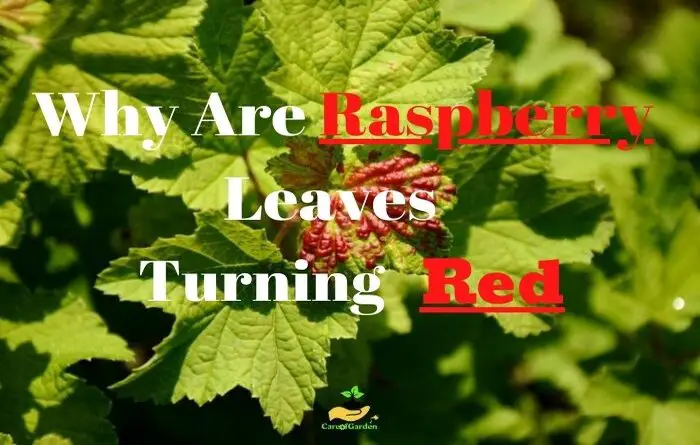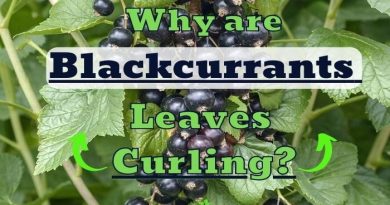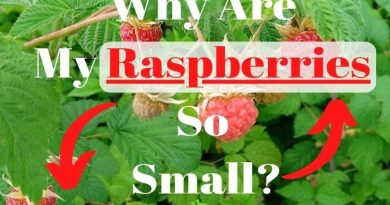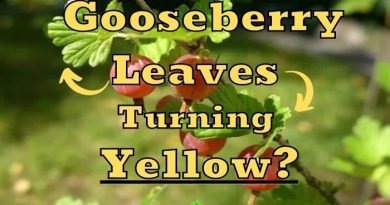Raspberry Leaves Turning Red (5 Causes And Solutions)
The causes of raspberry leaves turning red can be very diverse, this article will help to deal with them in more detail and learn about the methods of saving the raspberry.
For many gardening lovers, the condition of crops in the garden is very important: leaves, stems and roots, everything must be in perfect condition, because only from healthy plants can you get a sufficient amount of crop and healthy offspring.
Causes of Reddening of Raspberry Leaves
| Causes of Raspberry Leaves Turning Red |
|---|
| 1. Phosphorus deficiency |
| 2. Low acidity of the soil |
| 3. Fungal diseases |
| 4. Pests |
| 5. Cold temperatures |
The reasons for the red leaves on raspberry in early summer are a lack of minerals in the soil, the spread of fungal infections and insect pests. The first symptoms appear in June against the green leaves. Red or crimson leaves with dark and dry spots are visible.
There are several reasons why bright red spots appear on the surface of the foliage.
In this article we will talk about the 5 most important causes why raspberry leaves are turning red :
1. Phosphorus deficiency
Phosphorus deficiency is the most common cause why raspberry leaves turn red. Phosphorus is considered the main nutrient that is needed for the development of the raspberry bush.
When the leaves are just beginning to turn red, the lack of phosphorus can be considered moderate. But after the leaves may turn purple, and this means that the raspberry plant is seriously starving.
The lack of this element negatively affects the fruiting and flowering of seedlings. The first symptoms of phosphorus deficiency appear in the during of spring, when buds should appear on the stems of the raspberry bushes.
If during the season dark reddish-brown spots with a bronze sheen appear on the leaves or the entire plant turns red, then this is a sign of a lack of a macronutrient. Affected leaves will then turn black and fall off.
Phosphorus deficiency is also shown by the fact that flowers with buds fall off the seedlings.
The surfaces of the leaves are covered with dark spots with a red tint. Gradually, all the affected foliage is deformed and begins to dry out. Thus, only phosphorus-containing feed mixtures can save raspberry plants.
How to fix Phosphorus deficiency
Apply phosphate fertilizer. It can be superphosphate or phosphate rock. November is already a late time for fertilizers, so as not to undermine the winter hardiness of raspberries, it is better to fertilize in the spring. Fertilizers are applied to the soil in spring and autumn.
Options for phosphorus-containing fertilizers:
- Double superphosphate (60 g / 1 m²) – feed in the spring after the snow melts;
- Phosphorite and bone meal fertilizer (50-70 g / 1 m²) – they are applied in the spring;
When raspberry leaves turn red already during the period of active growth, the cause may be a lack of nutrients.
In this case, top dressing is performed using magnesium sulfate and superphosphate (according to instructions). Fertilizers are applied at intervals of 2 weeks, monitoring the change in the color of the leaf plates.
Speaking of fertilizer, can instant coffee be used on vegetable plants? Find out in this article!
2. Low soil acidity (Low pH)
Low soil acidity or low soil pH is the second cause why raspberries leaves are turning red. Raspberries do not like pH neutral soils and if the soil is too acidic or too basic the leaves will start to turn red a few weeks after seedlings have been planted.
For normal development, raspberries need soil acidity at a level of 3.5–4.5 pH. This is due to the fact that the roots of the raspberry shrub do not have suction hairs. Their function is taken over by a special fungus called mycorrhiza.
The mycelium develops in symbiosis with the roots of the raspberry plant and helps it absorb nutrients. Mycorrhiza is able to develop normally only in an acidic environment. Alkalization of the soil leads to the death of the fungus.
How to fix Low soil pH
To increase soil acidity, dissolve 1 tsp. citric or oxalic acid in 3 liters of water, or dilute 100 ml of 9% acetic acid in 10 liters of water.
Fertilize the soil with the resulting liquid.
Don’t be discouraged if the raspberry leaves are slow to turn green after adding the acid. Give the plant a couple of days, because it is not only experiencing a lack of acid, but also stress due to a change in location.
3. Fungal diseases
Another reason why raspberry leaves are turning red and dry is the development of fungal diseases. Common diseases that are caused by a fungus include:
| Diseases | Description |
| Anthracnose | Symptoms of the disease appear on leaves, berries, stems and buds. First, small red dots appear on the raspberry leaves, the size of which gradually increases turning into red spots. |
| Red Stele Rot (Phytophthora fragariae) | The roots rot and raspberry leaves take on a reddish color. Poor drainage and cool soils encourage the development of these fungi. |
| Septoria (Leaf Spot) | Microscopic fungus penetrates through the root system. Note that first of all, the lower leaves are covered with red spots and then the leaves dry up and fall off. Most often affects raspberry bushes. |
| Raspberry spur blight | Spots that oscillate between red-brown and purple appear on the twigs, around the buds. The shoots dry up and the twigs grow poorly or not at all. |
| Verticillium wilt | This is a dangerous disease, due to which the yield is reduced by 2-3 times. Symptoms of verticillium wilt include drying of the leaves and cracking of the stems. |
Is Nettle Fertilizer Good for Tomatoes? Here is the answer!
Anthracnose
It appears on young shoots, immediately after flowering, as light gray spots with a wide reddish to purple border, which gradually merge, become dark, dry out and turn into gray longitudinal ulcers.
Small cracks appear on dead tissues, the bark exfoliates. Lateral branches and leaves on the affected shoots dry out. On the leaf plates, grayish spots with a purple border are also found, scattered along the veins.
Anthracnose is one of the most important raspberry diseases along with spur blight. The damage is significant during cool and rainy spring and early summer.
To control the fungus responsible for anthracnose :
After harvesting, without delay, remove the fruiting shoots. Avoid thickening of soil.
Spray in the spring with 1% Bordeaux mixture. If the lesion is severe, repeat spraying after harvesting and stripping the raspberries from diseased shoots.
Increase natural resistance of raspberry plants by repeatedly spraying nitrogen-rich nettle manure (diluted 5 or 10%) on the leaves until July.
Raspberry Red Stele Rot
Red leaves on a raspberry plant, for example, is a telltale sign of red stele rot, a potentially serious disease of raspberry plants that requires immediate action by the grower to ensure both the safety of the fruit and of the long-term health of the raspberry plant.
Red Steel, the fungal pathogen Phytophthora fragariae causes red stele. Phytophthora fragariae lives in the soil, generally in poorly drained, moist, clay-laden soils that occur in cold weather.
As the disease progresses, the leaves turn red, blue, green, and yellow in color and tend to take on a metallic sheen. The most important symptom of this disease is the primary red color that the raspberry leaves, or the center of the root structure, takes on.
In its later stages, red stele will kill the raspberry plant before the raspberry fruit fully ripens.
The disease is usually spread by planting equipment or planting medium (potting soil, etc.) becoming contaminated with the fungus and being used on or near raspberry plants.
Early spring, late winter and late fall see more incidences of this disease than other times of the year because, at these times, soil conditions tend to be more conducive to the growth of the Phytophthora fragariae fungus.
Septoria (Leaf Spot)
Septoria or white rot, as it is popularly called, mainly appears on young plants, and with timely treatment does not cause much harm. First, the lower raspberries leaves are covered with red spots, but then the bush begins to dry.
Affected shoots, buds and leaves die off, bushes weaken and lose their ability to produce crops.
To control septoria in raspberries follow these steps:
- Affected leaves must be immediately cut and burned.
- Raspberries and blackberries should be sprayed with Bordeaux mixture or a 0.5% solution of copper oxychloride.
- For prevention, the bushes need to be treated 3-5 times per season (with an interval of 7-10 days)
Raspberry spur blight
Didymella applanata fungus causes the disease called raspberry spur blight (raspberry cancer). Initially it affects the leaf margins, then it reaches the central rib, then the foliar petiole and finally affects the whole shoot.
The disease is caused by a fungus and often appears due to waterlogging of the soil. Small dark red spots appear on the leaves, then the leaves turn completely red, and the shoot dries up. At the first sign of the disease, all infected branches must be cut and burned.
Spots that oscillate between red-brown and purple appear on the raspberry, around the buds. The shoots dry up and the twigs grow poorly or not at all.
To get rid of the disease, 3 treatments are required: 2 of them are carried out before flowering, and the last, after picking berries in July.
Does you pepper leaves turn purple? I have for you the main causes and how to treat them!
4. Insect pests
The reasons for the development of red spotting include the attack of pests on raspberries seedlings.
There are several pest insects that frequently appear on raspberry bushes:
| Insects pests | Description |
|---|---|
| Gall midges | This is a small yellowish mosquito that damages the leaves and stems of raspberries. Reddish dots form on damaged areas of raspberry leaves. If the gall midge isn’t removed in time, it will damage more than 80% of the shoots. |
| Raspberry beetle | When this pest appears on the raspberry leaves, reddish swellings appear on their surface. Damaged foliage cracks and dries. |
| Aphids | Are the most common pests that appears on raspberry crops. First of all, the aphid harms the young inflorescence and shoots. However, gradually the number of pests increases throughout the bush and helps to redden the raspberry leaves. |
| Gall midges |
|---|
| Appearance: The gall midge looks like an orange small mosquito that appears in early summer and feeds on plant sap. |
| Signs: – gall midges appear on the site, which are easy to notice when examining raspberries; – small red dots appear on infected raspberries, which then expand. |
| How to treat: Insecticides such as “Bordeaux mixture”, help from gall midge |
| Aphids |
|---|
| Appearance: The aphid looks like a small green or brown bug that lays translucent eggs. |
| Signs: – young shoots and leaves are covered with small red spots; – pests spread throughout the bush and can be seen on the back of the leaves; – in the later stages of infection, the bush weakens, grows poorly and fades. |
| How to treat: Folk remedies help with aphids, for example, infusion of ash, tobacco, zest or tomato. |
| Raspberry beetle |
|---|
| Appearance Raspberry bug reaches 2 mm in size, usually brown or black. |
| Signs: – the beetle damages the leaves and stems of the raspberries, so they begin to dry; – the raspberry bush turns red from a lack of phosphorus, develops more slowly and does not bear fruit; – white larvae appear inside the berries, which eat the fruits from the inside. |
| How to treat: Insecticides will help get rid of this pest. |
5. Cold temperatures
In the first half of spring, young raspberry leaves often turn red due to cold and night frosts. In such a situation, there is no need to rush to acidify the soil and apply any fertilizers: after a couple of weeks, when it gets warmer, the leaves of the shrub will acquire a natural green color.
Don’t rush and try to perform treatments on the raspberry, instead you can apply fungal treatments for fungal diseases. Inspect the raspberry leaves for a few weeks and see if the leaves are returning to the normal green color.
If a forecast of cold weather is ahead, raspberries can be protected from low temperatures with covering material (young seedlings are often covered with spruce branches).
Is your Bell Pepper turning brown? Here are the main causes and step by step how to fix it!
How to Prevent Raspberry Leaves Turning Red
So that the leaves of the raspberry plant never turning red, you need to familiarize yourself with how to prevent this problem. Raspberry bushes get sick less often if their roots are protected from mechanical damage.
Also, to prevent the development of diseases, it is necessary to regularly feed the raspberry bushes with organic matter and mineral fertilizers. It is recommended that the top dressing be added 4-5 times per season.
To prevent raspberry leaves from turning red here is what should do:
- Regular spraying of raspberries with fungicides;
- Transplanting bushes to a new place every 5-7 years;
- Periodically prune to remove weakened or diseased shoots.
- Regular and sufficient watering.
- Timely fertilizing.
- Removal of weeds.
- Mulching raspberry bushes.
- Carrying out preventive spraying with insecticides and fungicides before planting.
1.As soon as the snow melts and the soil begins to warm up, clean up the area where the raspberries grow: cut off the frostbitten tops of the shoots, remove the stems that are broken or different in color, as well as those that grow inside the bush.
2. Spray the raspberries during in the spring with Bordeaux mixture as a preventive measure. You need to spray the raspberry bushes, but also the soil under them. The first spraying should be carried out before the buds begin to bloom. If it will be necessary, you can repeat the treatment in the spring and in the summer depends on what ailments you noticed in raspberries last year.
3. If during the last growing season you noticed the appearance of some pests on raspberries, then fight them using information provided above. Treat raspberries crops with insecticides in accordance with the type of pest and as many times as necessary to get rid of them. We recommend the last insecticide treatment of the season should be carried out after harvesting.
4. Applying mineral fertilizers with a high content is the only way to cope with the lack of phosphorus. It is better to do it in a diluted form. In general, a lack of phosphorus is typical for poor forest lands, and therefore an experienced gardener will always try to prevent the situation, which will deal with the consequences.
5. In anticipation of winter, cut to the very root of the stems of the second year, which will no longer bear fruit, as well as weak and diseased shoots. Shorten the shoots of the first year that will produce berries next year to a height that you can reach with a pruner. After that, remove all leaves from the stems.
Conclusion
The raspberries are a garden crop that is grown by many gardeners because they do not require special care. Usually rare top dressing and timely cutting of the stems is enough for the plants to will reward you with tasty and sweet berries every year.
Sometimes raspberry leaves turn red but gardeners are sure that this is mainly due to the lack of mineral components in the soil, especially phosphorus.
Red leaves on raspberries is an alarming sign that the plant is suffering from diseases or pests, does not receive the nutrients it needs. Taking timely measures allows you to save the raspberry.
RELATED TOPICS: Do your raspberry leaves turn yellow? Here are 6 reasons why raspberry leaves turn yellow and solution how to treat yellow leaves!
RELATED TOPICS: Does your raspberry are small in size? In this article I will show the 5 causes and the treatments to allow you to restore raspberry size!
RELATED TOPICS: Do you have small grapes? In this article I present what causes grapes to not grow properly and how to treat this issue!




